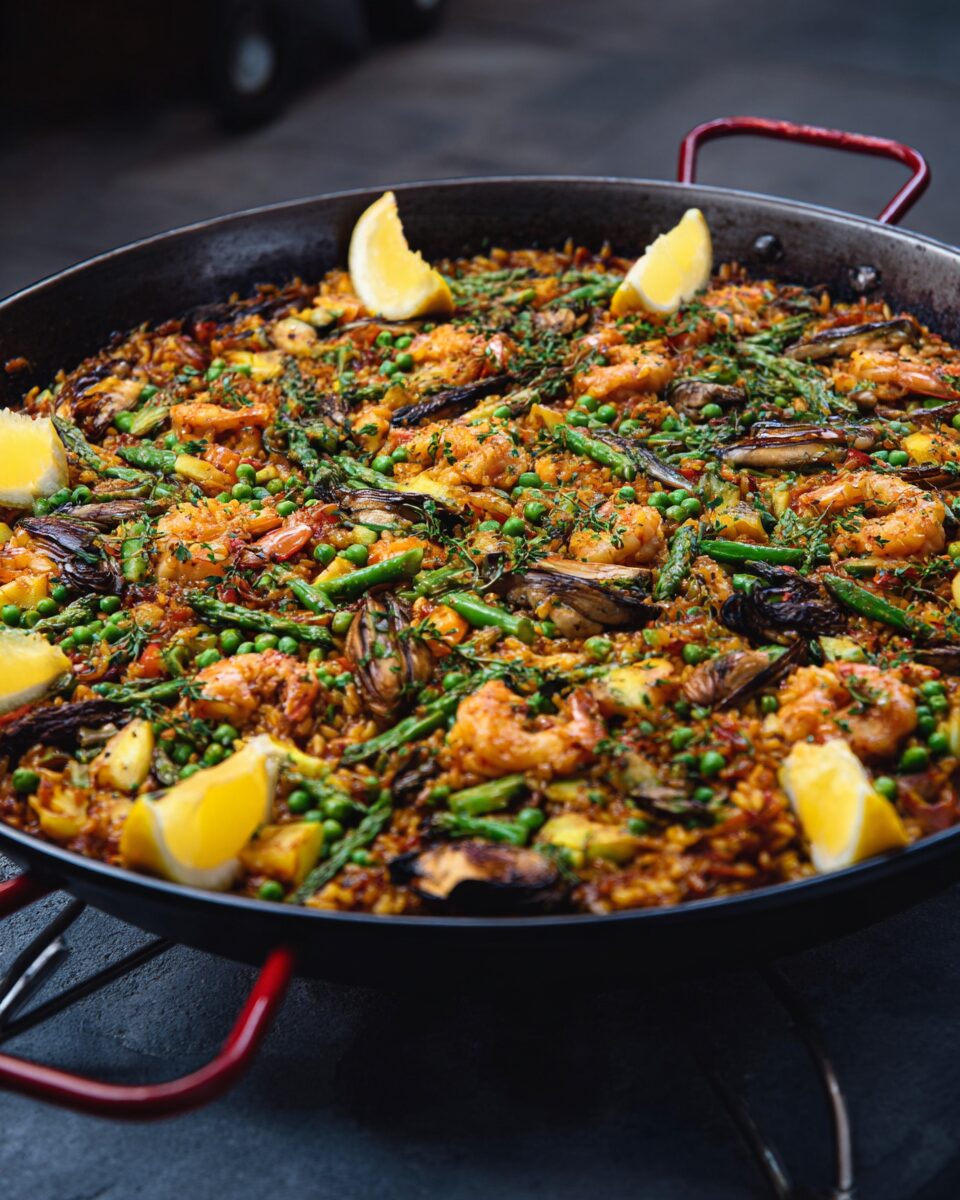The Vegetable Paella is a vibrant and colorful dish, showcasing the beauty of fresh, seasonal vegetables. The sweet peppers, zucchini, and juicy tomatoes combine with earthy spices to create a flavorful, satisfying meal. Paired with the creamy texture of the rice and the smoky flavor of paprika, this dish is perfect for a family dinner or a potluck gathering.
Not only is this Vegetable Paella visually stunning, but it’s also versatile! Feel free to swap out the vegetables based on what’s in season or to suit your preferences. Add a squeeze of lemon for extra brightness or top with some olives for a Mediterranean twist. It’s a meal that’s as delicious as it is customizable.
Full Recipe:
-
1 tablespoon olive oil
-
1 onion, chopped
-
2 cloves garlic, minced
-
1 red bell pepper, chopped
-
1 yellow bell pepper, chopped
-
1 zucchini, chopped
-
1 cup cherry tomatoes, halved
-
1 cup peas (fresh or frozen)
-
1 1/2 cups Arborio rice
-
3 cups vegetable broth
-
1/2 teaspoon smoked paprika
-
1/4 teaspoon turmeric
-
1/2 teaspoon ground cumin
-
Salt and pepper to taste
-
Fresh parsley, chopped, for garnish
Directions:
-
Heat olive oil in a large pan over medium heat. Add chopped onion and garlic and sauté for about 2 minutes until softened.
-
Add bell peppers, zucchini, and cherry tomatoes. Cook for 5 minutes, stirring occasionally.
-
Stir in Arborio rice, smoked paprika, turmeric, cumin, salt, and pepper, and cook for another 2 minutes.
-
Pour in the vegetable broth and bring to a boil. Reduce the heat, cover, and let simmer for 15-20 minutes, or until the rice is tender and most of the liquid has been absorbed.
-
Stir in the peas and cook for an additional 5 minutes until heated through.
-
Remove from heat and let sit, covered, for 5 minutes before serving.
-
Garnish with fresh parsley and serve.
Prep Time: 15 minutes | Cooking Time: 25 minutes | Total Time: 40 minutes
Kcal: 320 kcal | Servings: 4 servings
History and Origin
The origins of paella trace back to the region of Valencia on Spain’s east coast. This dish was traditionally a humble meal prepared by rural workers who would cook it over an open flame in large, shallow pans. The key ingredients of classic paella were simple: rice, vegetables, and whatever proteins were available—often chicken, rabbit, or seafood. Over time, paella became a symbol of Spanish cuisine, with regional variations popping up across the country.
Valencia remains the heart of paella, and the dish is still made using specific techniques passed down through generations. While traditional paella recipes typically feature meat or seafood, Vegetable Paella is a modern take on the dish, catering to plant-based eaters and those looking to enjoy a lighter, vegetarian version. This variation highlights the versatility of paella, as it can be easily adapted to suit any dietary preference or availability of ingredients.
The inclusion of vegetables like bell peppers, zucchini, tomatoes, and peas not only brings a burst of color but also infuses the dish with layers of flavor that complement the rice beautifully. Whether you’re in Spain or somewhere else in the world, Vegetable Paella offers a taste of Mediterranean warmth and hospitality.
Variations and Adaptations
While the traditional Valencian paella is made with a variety of proteins, the vegetable version provides endless opportunities for creativity and customization. Depending on what vegetables are in season or your personal preferences, you can tweak this dish to suit your tastes. Here are some popular variations:
-
Grilled Vegetables Paella: For an added smoky flavor, consider grilling your vegetables before adding them to the paella pan. Grilled bell peppers, eggplant, or mushrooms can elevate the dish with an extra depth of flavor.
-
Saffron or Turmeric Variations: Traditional paella often uses saffron, but if you’re looking for a more affordable option, turmeric can be used to create a similar vibrant yellow hue while providing a slightly different taste. Some regions of Spain prefer using saffron while others make use of locally available spices.
-
Seasonal Vegetable Paella: Depending on what’s available at your local market, you can swap in seasonal vegetables like pumpkin, asparagus, or green beans. The beauty of Vegetable Paella is its flexibility to showcase fresh, in-season produce.
-
Rice Variations: Though Arborio rice is a common choice for paella due to its creamy texture, other varieties like short-grain brown rice or even quinoa can be used for a healthier twist. Brown rice adds a nuttier flavor and extra fiber, while quinoa offers a gluten-free alternative.
-
Add-Ins: While this version is purely plant-based, you can add extras like olives, capers, or nuts for an extra pop of flavor. A drizzle of lemon juice or a sprinkle of fresh herbs like parsley or basil before serving can bring a burst of freshness.
Nutritional Information
Vegetable Paella is not only flavorful, but it’s also packed with nutrients. The vegetables provide a generous dose of vitamins and minerals, while the rice offers a satisfying base of carbohydrates. Here’s a breakdown of the nutritional value per serving:
-
Calories: 320 kcal
-
Carbohydrates: 56g
-
Protein: 7g
-
Fat: 7g
-
Fiber: 6g
-
Sugars: 7g
-
Vitamin A: 25% of the daily recommended intake (due to bell peppers and tomatoes)
-
Vitamin C: 30% of the daily recommended intake (from bell peppers, tomatoes, and peas)
-
Iron: 10% of the daily recommended intake (from the vegetables and rice)
-
Potassium: 15% of the daily recommended intake (from the vegetables and vegetable broth)
This dish is a great source of fiber, which promotes digestive health and helps to maintain stable blood sugar levels. Additionally, the abundance of vegetables provides a variety of antioxidants, which support immune function and reduce inflammation. The healthy fats from olive oil add a satisfying richness while also benefiting heart health.
Serving Suggestions and Pairings
Vegetable Paella is a hearty dish on its own, but it can be paired with a variety of sides and beverages to create a well-rounded meal. Here are a few ideas to elevate your paella experience:
-
Side Dishes: A fresh green salad with a tangy vinaigrette would be a great contrast to the richness of the paella. Consider pairing the dish with roasted garlic bread or a side of sautéed spinach or kale for added greens. If you’re serving the paella for a larger crowd, a Spanish-inspired tapas platter featuring olives, roasted almonds, and grilled vegetables would complement the dish beautifully.
-
Drinks: Vegetable Paella pairs wonderfully with a crisp, dry white wine such as Albariño, a Spanish varietal that complements the vibrant flavors without overpowering the dish. For non-alcoholic options, a sparkling citrus soda or a chilled herbal iced tea would be refreshing choices.
-
Toppings: Just before serving, sprinkle a generous handful of fresh herbs, such as parsley or cilantro, for added brightness. You can also add a squeeze of lemon juice to enhance the flavors and balance the richness of the dish.
-
Desserts: For dessert, consider serving a light and refreshing Spanish flan or churros dusted with cinnamon and sugar. These sweet treats are a lovely way to end a Mediterranean-inspired meal.
Tips and Tricks for Success
-
Sauté Vegetables First: Ensure that you sauté the vegetables thoroughly before adding the rice. This will help release their natural flavors and prevent them from becoming too mushy during cooking.
-
Don’t Stir Too Much: One of the key characteristics of paella is its distinct crispy bottom layer, known as “socarrat.” To achieve this, resist the urge to stir the rice constantly. Once you add the broth, allow it to cook undisturbed to allow the rice to absorb all the flavors.
-
Adjust Liquid According to Rice Type: Depending on the type of rice you’re using, you may need to adjust the amount of liquid. Arborio rice absorbs a lot of liquid, while other varieties, like brown rice, require slightly more.
-
Use a Paella Pan: If possible, use a traditional paella pan. The wide, shallow design helps the rice cook evenly and ensures a crispy bottom layer. However, a large skillet or sauté pan will work just fine if you don’t have a paella pan.
-
Rest Before Serving: Let the paella rest for about 5 minutes after cooking. This allows the flavors to settle and the rice to firm up a bit, making it easier to serve.
Potential Health Benefits
The ingredients in Vegetable Paella offer a variety of health benefits. For instance:
-
Bell Peppers: Rich in vitamin C, bell peppers support immune function and healthy skin. They also contain antioxidants that help fight free radicals in the body.
-
Zucchini: A low-calorie vegetable that is high in water content, zucchini helps to keep you hydrated while providing essential nutrients like potassium and vitamin A.
-
Tomatoes: Packed with lycopene, tomatoes promote heart health and help protect against certain types of cancer. They’re also a great source of vitamins C and K.
-
Olive Oil: Rich in heart-healthy monounsaturated fats, olive oil is known to reduce the risk of cardiovascular disease and inflammation.
Together, these ingredients provide a nutrient-dense meal that supports overall health, digestive function, and immune strength.
Conclusion
Vegetable Paella is a versatile, delicious dish that showcases the beauty and flavors of Mediterranean cuisine. Its colorful combination of vegetables, aromatic spices, and savory rice makes it both satisfying and visually stunning. Whether you’re cooking for yourself, your family, or a group of friends, this dish is sure to impress. With its numerous variations and easy-to-follow preparation, Vegetable Paella is a meal everyone can enjoy—plant-based or not. So, why not give this vibrant dish a try? It’s an easy and delicious way to bring the tastes of Spain right to your table.





